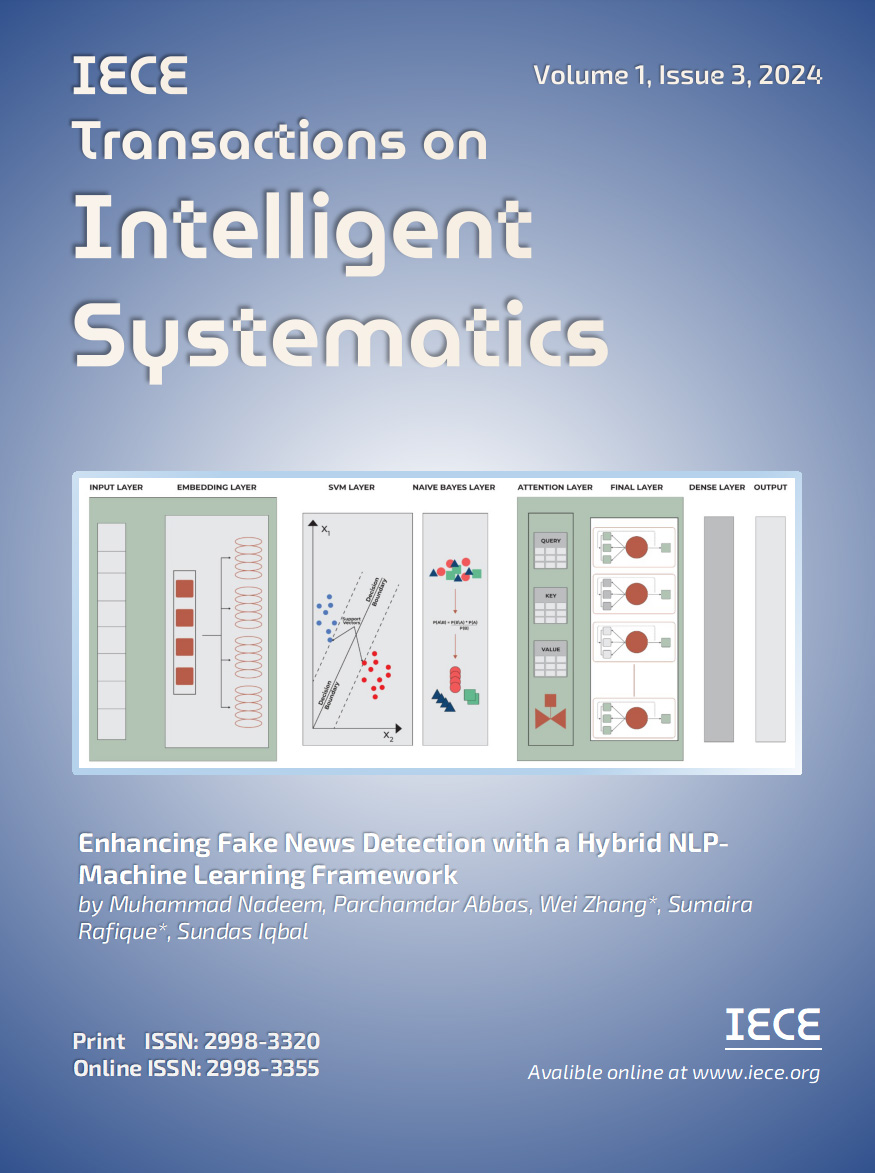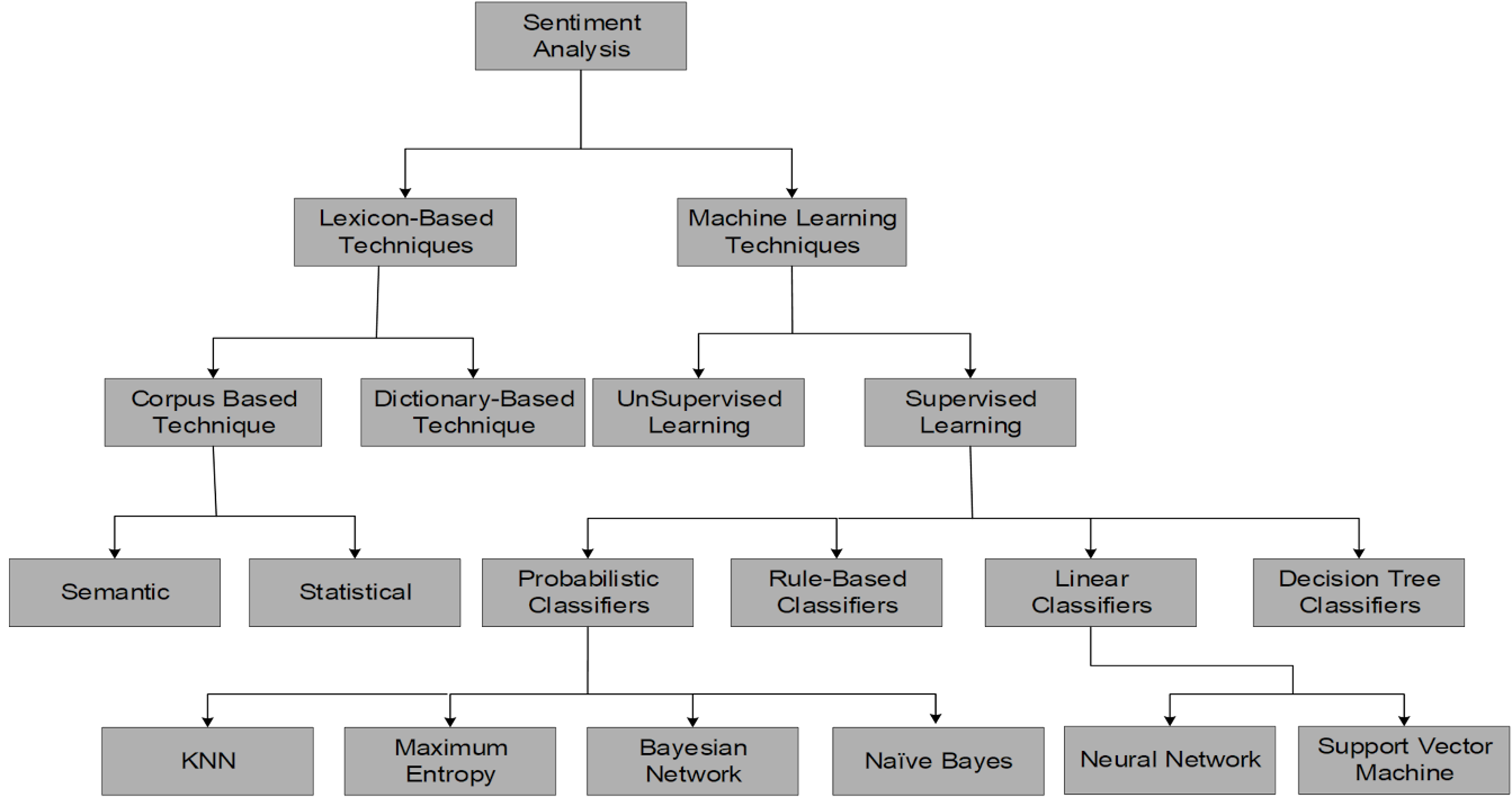IECE Transactions on Intelligent Systematics
ISSN: 2998-3355 (Online) | ISSN: 2998-3320 (Print)
Email: [email protected]


 Submit Manuscript
Edit a Special Issue
Submit Manuscript
Edit a Special Issue

[1] Mukhtar, N., & Khan, M. A. (2018). Urdu sentiment analysis using supervised machine learning approach. International Journal of Pattern Recognition and Artificial Intelligence, 32(02), 1851001.
[2] Ghulam, H., Zeng, F., Li, W., & Xiao, Y. (2019). Deep learning-based sentiment analysis for roman urdu text. Procedia computer science, 147, 131-135.
[3] Ali, D., Huque, M. T., Godhuli, J. J., & Ahmed, N. (2022). Detection of Face Emotion and Music Recommendation System using Machine Learning. International Journal of Research and Innovation in Applied Science, 7(11), 05-08.
[4] Ali, D., Iqbal, S., Mehmood, S., Khalil, I., Ullah, I., Khan, H., & Ali, F. (2024). Unleashing the Power of AI in Communication Technology: Advances, Challenges, and Collaborative Prospects. In Artificial General Intelligence (AGI) Security: Smart Applications and Sustainable Technologies (pp. 211-226). Singapore: Springer Nature Singapore.
[5] Amin, R., Gantassi, R., Ahmed, N., Alshehri, A. H., Alsubaei, F. S., & Frnda, J. (2024). A hybrid approach for adversarial attack detection based on sentiment analysis model using Machine learning. Engineering Science and Technology, an International Journal, 58, 101829.
[6] Khan, H., Ullah, I., Shabaz, M., Omer, M. F., Usman, M. T., Guellil, M. S., & Koo, J. (2024). Visionary vigilance: Optimized YOLOV8 for fallen person detection with large-scale benchmark dataset. Image and Vision Computing, 149, 105195.
[7] Dar, G., Bhagat, A., Ansarullah, S., Othman, M., Hamid, Y., Alkahtani, H., Ullah, I. & Hamam, H. (2023). A novel framework for classification of different Alzheimer’s disease stages using CNN model. Electronics, 12, 469.
[8] Ali, D., Younis, B., & Iqbal, S. (2024). A DEEP LEARNING TECHNIQUE FOR CLASSIFYINGIMAGES OF BRAIN TUMOR. Exceed Journal of Biological and Computer Sciences, 1(1).
[9] Mukhtar, N., Khan, M. A., & Chiragh, N. (2017). Effective use of evaluation measures for the validation of best classifier in Urdu sentiment analysis. Cognitive Computation, 9, 446-456.
[10] Rehman, Z. U., & Bajwa, I. S. (2016, August). Lexicon-based sentiment analysis for Urdu language. In 2016 sixth international conference on innovative computing technology (INTECH) (pp. 497-501). IEEE.
[11] Khan, H., Ullah, M., Al-Machot, F., Cheikh, F. A., & Sajjad, M. (2023). Deep learning based speech emotion recognition for Parkinson patient. Electronic Imaging, 35, 298-1.
[12] Saeed, M., Ahmed, N., Mehmood, A., Aftab, M., Amin, R., & Kamal, S. (2023). Sentiment analysis for covid-19 vaccine popularity. KSII Transactions on Internet and Information Systems (TIIS), 17(5), 1377-1393.
[13] Khan, H., Hussain, T., Khan, S. U., Khan, Z. A., & Baik, S. W. (2024). Deep multi-scale pyramidal features network for supervised video summarization. Expert Systems with Applications, 237, 121288.
[14] Mehmood, K., Essam, D., Shafi, K., & Malik, M. K. (2019). Discriminative feature spamming technique for roman urdu sentiment analysis. IEEE Access, 7, 47991-48002.
[15] Ahmed, N., Amin, R., Ayub, H., Iqbal, M. M., Saeed, M., & Hussain, M. (2022). Urdu Sentiment Analysis Using Deep Attention-Based Technique. Foundation University Journal of Engineering and Applied Sciences (HEC Recognized Y Category, ISSN 2706-7351), 3(1), 1-12.
[16] Mehmood, F., Ghani, M. U., Ibrahim, M. A., Shahzadi, R., Mahmood, W., & Asim, M. N. (2020). A precisely xtreme-multi channel hybrid approach for roman urdu sentiment analysis. IEEE Access, 8, 192740-192759.
[17] Syed, A. Z., Aslam, M., & Martinez-Enriquez, A. M. (2010). Lexicon based sentiment analysis of Urdu text using SentiUnits. In Advances in Artificial Intelligence: 9th Mexican International Conference on Artificial Intelligence, MICAI 2010, Pachuca, Mexico, November 8-13, 2010, Proceedings, Part I 9 (pp. 32-43). Springer Berlin Heidelberg.
[18] Ahmed, N., Amin, R., Aldabbas, H., Koundal, D., Alouffi, B., & Shah, T. (2022). Machine learning techniques for spam detection in email and IoT platforms: analysis and research challenges. Security and Communication Networks, 2022(1), 1862888.
[19] Pal, R., Adhikari, D., Heyat, M. B. B., Ullah, I., & You, Z. (2023). Yoga meets intelligent internet of things: recent challenges and future directions. Bioengineering, 10(4), 459.
[20] Rajalakshmi, S., Asha, S., & Pazhaniraja, N. (2017, March). A comprehensive survey on sentiment analysis. In 2017 fourth international conference on signal processing, communication and networking (ICSCN) (pp. 1-5). IEEE.
[21] Khan, L., Amjad, A., Afaq, K. M., & Chang, H. T. (2022). Deep sentiment analysis using CNN-LSTM architecture of English and Roman Urdu text shared in social media. Applied Sciences, 12(5), 2694.
[22] Ahmed, N., Amin, R., Aldabbas, H., Saeed, M., Bilal, M., & Song, H. (2024). A Novel Approach for Sentiment Analysis of a Low Resource Language Using Deep Learning Models. ACM Transactions on Asian and Low-Resource Language Information Processing.
[23] Ahmed, N., Amin, R., Ayub, H., Iqbal, M. M., Saeed, M., & Hussain, M. (2022). Urdu Sentiment Analysis Using Deep Attention-Based Technique. Foundation University Journal of Engineering and Applied Sciences (HEC Recognized Y Category, ISSN 2706-7351), 3(1), 1-12.
[24] Rajalakshmi, S., Asha, S., & Pazhaniraja, N. (2017, March). A comprehensive survey on sentiment analysis. In 2017 fourth international conference on signal processing, communication and networking (ICSCN) (pp. 1-5). IEEE.
[25] Chandio, B. A., Imran, A. S., Bakhtyar, M., Daudpota, S. M., & Baber, J. (2022). Attention-based RU-BiLSTM sentiment analysis model for roman Urdu. Applied Sciences, 12(7), 3641.
[26] Li, D., Ahmed, K., Zheng, Z., Mohsan, S. A. H., Alsharif, M. H., Hadjouni, M., ... & Mostafa, S. M. (2022). Roman Urdu sentiment analysis using transfer learning. Applied Sciences, 12(20), 10344.
[27] Khan, L., Amjad, A., Ashraf, N., Chang, H. T., & Gelbukh, A. (2021). Urdu sentiment analysis with deep learning methods. IEEE access, 9, 97803-97812.
[28] Ahmed, M. J., Afridi, U., Shah, H. A., Khan, H., Bhatt, M. W., Alwabli, A., & Ullah, I. (2024). CardioGuard: AI-driven ECG authentication hybrid neural network for predictive health monitoring in telehealth systems. SLAS technology, 29(5), 100193.
[29] Khan, L., Amjad, A., Ashraf, N., & Chang, H. T. (2022). Multi-class sentiment analysis of urdu text using multilingual BERT. Scientific Reports, 12(1), 5436.
[30] Ahmed, K., Nadeem, M. I., Li, D., Zheng, Z., Al-Kahtani, N., Alkahtani, H. K., ... & Mamyrbayev, O. (2023). Contextually enriched meta-learning ensemble model for Urdu sentiment analysis. Symmetry, 15(3), 645.
[31] Sehar, U., Kanwal, S., Dashtipur, K., Mir, U., Abbasi, U., & Khan, F. (2021). Urdu sentiment analysis via multimodal data mining based on deep learning algorithms. IEEE Access, 9, 153072-153082.
[32] Mehmood, K., Essam, D., Shafi, K., & Malik, M.K. (2019). Sentiment analysis for a resource poor language—Roman Urdu. ACM Transactions on Asian and Low-Resource Language Information Processing (TALLIP), 19(1), 1-15.
[33] Ahmad, P. N., Liu, Y., Ullah, I., & Shabaz, M. (2024). Enhancing coherence and diversity in multi-class slogan generation systems. ACM Transactions on Asian and Low-Resource Language Information Processing, 23(8), 1-24.
[34] Nasim, Z., & Ghani, S. (2020). Sentiment analysis on Urdu tweets using Markov chains. SN Computer Science, 1(5), 269.
[35] Asghar, M. Z., Sattar, A., Khan, A., Ali, A., Masud Kundi, F., & Ahmad, S. (2019). Creating sentiment lexicon for sentiment analysis in Urdu: The case of a resource-poor language. Expert Systems, 36(3), e12397.
[36] Mukhtar, N., Khan, M. A., Chiragh, N., & Nazir, S. (2018). Identification and handling of intensifiers for enhancing accuracy of Urdu sentiment analysis. Expert Systems, 35(6), e12317.
[37] Mukhtar, N., & Khan, M. A. (2020). Effective lexicon-based approach for Urdu sentiment analysis. Artificial Intelligence Review, 53(4), 2521-2548.
[38] Khan, K., Khan, W., Rahman, A. U., Khan, A., Khan, A., Khan, A. U., & Saqia, B. (2018). Urdu sentiment analysis. International Journal of Advanced Computer Science and Applications, 9(9).
[39] ul Mustafa, F., Ashraf, I., Baqir, A., Ahmad, U., Malik, S., & Mehmood, S. (2020, October). Prediction of user’s interest based on urdu tweets. In 2020 International Symposium on Recent Advances in Electrical Engineering & Computer Sciences (RAEE & CS) (Vol. 5, pp. 1-6). IEEE.
IECE Transactions on Intelligent Systematics
ISSN: 2998-3355 (Online) | ISSN: 2998-3320 (Print)
Email: [email protected]

Portico
All published articles are preserved here permanently:
https://www.portico.org/publishers/iece/